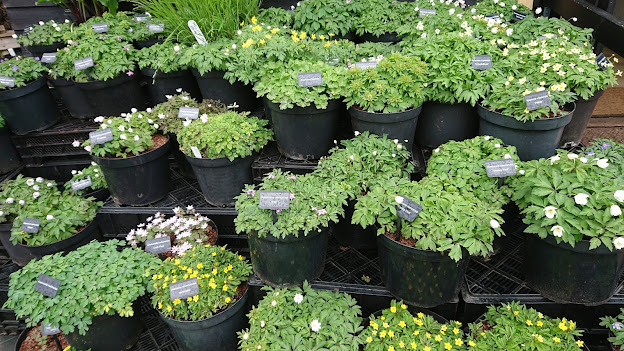Anemone.
I have always loved Anemones they certainly prove their value flowering early winter putting on a delicate display. Recently I had to catch the train into the city for 5 days always a good time to do some reading. After reading E A Bowles and his garden I was inspired to do an article on Anemones one of Bowles favourite genus. He started on his book on Anemone's so many times never quite completing it, his beautiful illustrated water colours, painted when he was almost blind were wasted as his book was never printed. I would like to read Bowles book on The Spring Garden next.
These two photos are of the Anemone plants that you can buy from Avondale Nursery, Coventry in the UK, presented at their Nursery. The plant labels I can read are as follows - Dicentra canadensis, Anemone ranunculoides, Anemone ranunculoides lacinata, Anemone ranunculoides ssp wockeana, Anemone x lipsiensis, Anemone x lipsiensis Palida, Anemone x lipsiensis Schwefelfeuer, Anemone nemorosa Bobs Your Uncle, Anemone nemorosa Wyatts Pink, Anemone nemorosa Dark leaf, Anemone nemorosa Flushing, Anemone nemorosa Slack Top Pink, Anemone nemorosa Lismore Blue, Anemone nemorosa Tilo, Anemone nemorosa grandiflora, Anemone nemorosa Lychette, Anemone nemorosa Parlez Vou, Anemone nemorosa Helsinki and lastly Anemone nemorosa La Rochanne. I think that is an impressive list and there are Anemonellas on display to for sale. Avondale Nursery hold the National collection of anemones. Their Anemone collection of wood Anemones are grown in containers rather than in the garden to stop rogue seedlings, and to prevent varieties from running into one another. Thank you Dean Croucher for emailing your two photos, I was just blown away with the variety in them.
Anemone nemorosa growing wild in Wales, all along the road sides and verges and in the Beech forests, in large sheets they were every where. Anemone nemorosa will thrive in a semi shade to a shaded position. They have long roots that will spread through the leaf mould, and will make a large clump quite easily.
Anemone nemorosa Lady Doneraile.
Anemone nemorosa Robinsoniana one of my oldest Anemone from Ken Gillanders Nursery Tasmania and still one of my favourites.
Anemone nemorosa Lychette.
Anemone nemorosa Bowles Purple.
Anemone ? Blackthorn Nursery UK above, this Anemone was collected on Picos de Europa by Peter Erskine & others, thought to be a cross, this was taken 2011 so it may have been named by now. Below shows the planting combinations that look so beautiful together, of the same plant in Vale Cottage Garden, Peter Erskine UK.
Anemone nemorosa viridescense.
Anemone nemorosa Vestal Blackthorne Nursery UK 2011.
Anemone nemorosa double pale pink Blackthorn Nursery UK 2011
Anemone narcissiflora Mulleres Valley Spain growing in a moist woodland position.
Anemone hortensis from Archibald seed which I seem to have lost in my move, but I have new seed coming up from Craig at Sunnymead ex Phyll Bear. It is a beautiful colour.
Anemone apennina Blue
Anemone apennina white and blue flowers.
Anemone Blanda Wisley Gardens UK a large drift.
All the beautiful forms of Anemone blanda found growing in rocky scrub and woodland positions from the Balklands eastwards to Turkey.
Anemone blanda Radar.
Anemone blanda.
Anemone x lipsiensis is the earlier name given to this Anemone but may be called Anemone x seemannii, my all time favourite Anemone a lovely soft creamy lemon flowers, given to me by Otto 22 years ago. This woodland Anemone needs to be kept moist not wet and not dry out during summer months. It is sometimes found in the wild where the parent species Anemone nemorosa and Anemone ranunculoides grow in close proximity to each other, a beautiful hybrid.
Anemone rivularis white flowers flushed with violet on the outside petals, a very vigorous Anemone too large for the rock garden, never the less worth a place in other parts of the garden and it is a tough plant and easy from seed Himalaya and southwestern China. Just remove seed heads after flowering to prevent self sowing.
Anemone fanninii a little known Anemone, but one of the largest, reaching a meter high with very large palmate felted leaves 350mm across and very large fragrant white flowers, with crowded yellow stamens. Only discovered in 1978 by Gibson in KwaZulu-Natal and the Eastern Cape of South Africa. My photo does not do this plant justice. It does not like to be too dry in Summer
Anemone heldreichii from the late Marcus Harvey. Found growing in Yugoslavia and central Medierranean - France in stony places in Olive groves and abandoned cultivation. I tend to grow this Anemone in a pot as it does better for me, when grown in the garden it gets lost and I can keep it fed properly when grown in a large pot.
Anemone obtusiloba (Pradesh) Edrom Nursery Scotland 2001.
Anemone obtusiloba Ediburgh Botanic Gardens Scotland.
Anemone pavonina Central and eastern Mediterranean in vineyards and cultivated lands, very easy from seed.
Anemone pavonina ex Phyll Bear.
Anemone rupicola rhizomatous and rare in cultivation. This species is from regions of high rainfall, so don't dry out this photo was taken at Wisley 2008. An absolutely gorgeous Anemone with it purple flush on the out side of the petals. Found growing moraines, cliffs and open slopes at 2,700-4,300meters Eastern Afganistan eastwards through the Himalaya to southwestern China. Of course there are many more Anemone not shown here just food for thought.































No comments:
Post a Comment